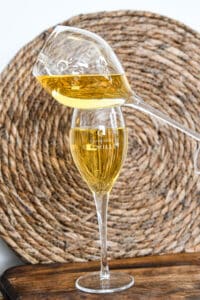
COMPOSITION OF CHAMPAGNE – OENOLOGICAL PARTICULARITIES
When discussing the composition of Champagne, one inevitably thinks of the three grape varieties that account for 99% of production: Pinot Noir, Meunier, and Chardonnay.
When discussing the composition of Champagne, one inevitably thinks of the three grape varieties that account for 99% of production: Pinot Noir, Meunier, and Chardonnay. Here are more details on the oenological elements that make up Champagne.
SUMMARY

When discussing the composition of Champagne, one inevitably thinks of the three grape varieties that account for 99% of production: Pinot Noir, Meunier, and Chardonnay. Here are more details on the oenological elements that make up Champagne.
Maison Gremillet offers you a more oenological approach to Champagne. While we’re at it, what is the definition of oenology? Etymologically, the word oenology is composed of the Greek roots « oînos » and « lógos, » meaning « wine » and « science. » It is, therefore, the science of wine, covering everything from advanced knowledge of the vine to wine production, including its preservation. This applies to both « still » wines and Champagne. A little oenology? In the Champagne vineyards, it’s important to know that three major grape varieties dominate: Pinot Noir, Meunier, and Chardonnay. Together, they represent 99% of production! Arbane, Petit Meslier, Pinot Blanc, and Pinot Gris are also permitted but remain scarcely used. At Gremillet, 85% of our vineyards are dedicated to Pinot Noir, while 15% are devoted to Chardonnay. The first brings its exceptional aromas and taste, while the second adds delicacy and floral notes. Our “Blanc de Noirs” Champagne is 100% Pinot Noir. The “Blanc de Blancs” is 100% Chardonnay. To refine your palate and perception of grape varieties, it’s a great opportunity to taste these two Champagnes. Beyond these tangible elements, what lies behind a bottle of Champagne? First of all, do you know how many grapes are required to produce a bottle of Champagne? On average, 1.5 kilos are needed! Each season, 50 hectares, yielding an average of 10,000 kg per hectare, are harvested on the Gremillet estate… To which is added the production of 80 winemakers who trust us. Ultimately, 500,000 bottles of Gremillet Champagne are produced every year. Beyond the grape, what else is in them? For more details, this article applies to both the composition of Brut Champagne and Rosé Champagne, with only some proportions changing.
Another key ingredient in Champagne, and certainly not the least, is carbon dioxide, the source of those joyful bubbles. It’s the Champagne method that transformed « still » wines into sparkling wines. After harvesting and pressing, the grape is allowed to ferment in vats or barrels. The sugars present gradually transform into alcohol under the action of yeasts… and into carbon dioxide. In the end, each bottle of Champagne contains between 5 to 8 liters of dissolved carbon dioxide! It’s thanks to this that Champagne is so eager to burst free when opened. Depending on temperature and atmospheric pressure, the internal pressure of the bottle can vary.
It may seem obvious, but Champagne is also composed of alcohols, which appear during fermentation. All Champagnes, regardless of dosage, have an alcohol content around 12%, or even 12.5%, but never more. Alcohol gives body to Champagne and allows it to be preserved over time (have you ever seen 10-year-old fruit juice?). It consists mainly of ethanol. Another type of alcohol present in Champagne is glycerol. This element, which represents about 10% of the alcohol content, gives Champagne its smooth, sweet character. Methanol (wood alcohol) is also present in small quantities, at a lower proportion than in any red wine, for comparison. Beyond alcohols and sugars (glucose and fructose), you will also find various minerals in Champagne that contribute to its flavor profile: potassium, calcium, magnesium, iron… And finally, vitamins, mainly B vitamins, and organic acids. The sugar content varies depending on the type of Champagne:
– **Doux**: more than 50g of sugar/liter
– **Demi-sec**: between 32g and 50g of sugar/liter
– **Sec**: between 17g and 32g of sugar/liter
– **Extra dry**: between 12g and 17g of sugar/liter
– **Brut**: less than 12g of sugar/liter
– **Extra brut**: between 3g and 6g of sugar/liter
Of course, we invite all curious minds who want to learn more to visit our estate, open to exploration. Perhaps some future oenologists are among you… And the Gremillet family loves nurturing new vocations!

When discussing the composition of Champagne, one inevitably thinks of the three grape varieties that account for 99% of production: Pinot Noir, Meunier, and Chardonnay.

For many decades, the production of Champagne has followed a precise and well-established process. The making of Champagne respects traditions and practices, which Maison Gremillet

Understanding the Difference Between Non-Vintage Brut Champagne and Vintage Champagne. The world of Champagne is vast and varied, offering a multitude of choices for wine